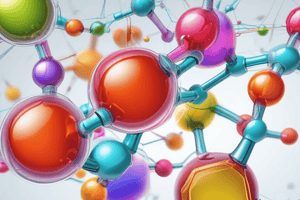Podcast
Questions and Answers
Which of the following is the atomic number of carbon?
Which of the following is the atomic number of carbon?
- 6 (correct)
- 12
- 5
- 8
What is the electron configuration of oxygen?
What is the electron configuration of oxygen?
- 1s2 2s2 2p2
- 1s2 2s2 2p4 (correct)
- 1s2 2s2
- 1s2 2s2 2p6
What is the molar mass of water (H2O)?
What is the molar mass of water (H2O)?
- 22 g/mol
- 20 g/mol
- 18 g/mol (correct)
- 16 g/mol
Which element is NOT a common member of heterocyclic compounds?
Which element is NOT a common member of heterocyclic compounds?
What percentage of US FDA-approved drugs contain nitrogen heterocycles?
What percentage of US FDA-approved drugs contain nitrogen heterocycles?
Which of the following is an example of a heterocyclic compound?
Which of the following is an example of a heterocyclic compound?
In organic heterocyclic chemistry, which types of rings are most commonly studied?
In organic heterocyclic chemistry, which types of rings are most commonly studied?
Which class of organic heterocycles refers to those fused to benzene rings?
Which class of organic heterocycles refers to those fused to benzene rings?
Flashcards
Carbon atomic number
Carbon atomic number
The number of protons in a carbon atom.
Oxygen electron configuration
Oxygen electron configuration
Arrangement of electrons in oxygen's orbitals.
Water's molar mass
Water's molar mass
Mass of one mole of water molecules.
Heterocyclic compound common element?
Heterocyclic compound common element?
Signup and view all the flashcards
Nitrogen heterocycles in drugs
Nitrogen heterocycles in drugs
Signup and view all the flashcards
Example of heterocyclic compound
Example of heterocyclic compound
Signup and view all the flashcards
Common heterocyclic ring sizes
Common heterocyclic ring sizes
Signup and view all the flashcards
Fused benzene derivatives
Fused benzene derivatives
Signup and view all the flashcards
Study Notes
Atomic Number and Electron Configuration
- Carbon has an atomic number of 6, indicating it has 6 protons in its nucleus.
- The electron configuration of oxygen is 1s² 2s² 2p⁴, showing its distribution of electrons across various atomic orbitals.
Molar Mass of Water
- The molar mass of water (H2O) is approximately 18.02 g/mol, derived from the molecular weights of its constituent elements: hydrogen (1.01 g/mol) and oxygen (16.00 g/mol).
Heterocyclic Compounds
- Common members of heterocyclic compounds include nitrogen, oxygen, and sulfur-containing rings; however, noble gases are NOT typically included in this group.
- A significant percentage of US FDA-approved drugs, estimated to be around 50%, contain nitrogen heterocycles, highlighting their importance in pharmacology.
Examples of Heterocyclic Compounds
- Examples of heterocyclic compounds include pyridine, furan, and indole, each playing critical roles in various biochemical applications.
Types of Rings in Organic Heterocyclic Chemistry
- In organic heterocyclic chemistry, five-membered and six-membered rings are the most commonly studied due to their stability and prevalence in natural products.
Class of Organic Heterocycles
- The class of organic heterocycles that refers to those fused to benzene rings is known as "fused heterocycles" or "polycyclic aromatic heterocycles," which can exhibit unique chemical properties.
Studying That Suits You
Use AI to generate personalized quizzes and flashcards to suit your learning preferences.




